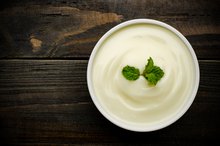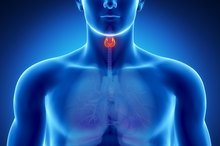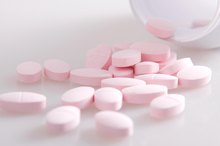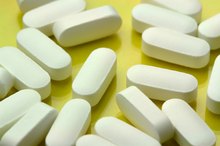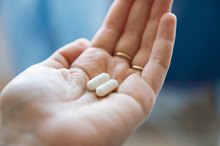Calcium's Effects on the Nervous System
Calcium is an essential mineral present in all of your body's cells, mostly in your bones and teeth, but in soft tissues as well. You can acquire calcium through foods and nutritional supplements, and it has a variety of effects on your body, including effects on your nervous system. Your nervous system comprises your brain, spinal cord and peripheral nerves that control body movement and cellular function. Talk with your doctor before using calcium supplements.
Cell Signaling
The main role calcium plays in regard to nervous system function is in cell signaling. Calcium is important in the contraction and expansion of blood vessels, nerve impulse transmission, muscle contraction and hormone production. In muscle cells, nerve endings release calcium ions, which bind to activator proteins. The activator proteins initiate the complex process of muscle contraction and allows your muscles to move. Without calcium, your muscles would not be able to contract and relax.
- The main role calcium plays in regard to nervous system function is in cell signaling.
- The activator proteins initiate the complex process of muscle contraction and allows your muscles to move.
Injury Response
What Are the Daily Values of Calcium for a 2000 Calorie Diet?
Learn More
Calcium may be a mediating factor in the initiation and regulation of responses of your nervous system to injury, according to a study published by the "Journal of Neurotrauma" in March 1992. The researchers found that when a cell becomes injured through trauma, your central nervous system sends calcium into the injured cell as a possible protective measure against further cellular damage. Calcium seeks out cells that are dead or dying and blocks your body from wasting metabolic resources trying to repair them.
Brain Development
Calcium appears to be involved in each phase of brain cell development during the early stages of life, according to a study published by the journal "Progress in Brain Research" in 2009. Calcium has the ability to regulate neuronal development and can direct both structural and functional adaptations in specific brain cells. When the calcium-dependent network of brain development does not work properly, sometimes resulting from a calcium deficiency in the mother during pregnancy, the risk of the fetus developing diseases such as autism or mental retardation increases, the researchers found.
Recommendations
Iodine's Effect on Calcium Absorption
Learn More
Your body requires a delicate balance of calcium in order to function optimally. Too much calcium, or hypercalcemia, can cause potentially serious side effects, and too little calcium, or hypocalcemia, can also have adverse effects. The recommended dietary intake of calcium, as set by the Food and Nutrition Board, is about 1,000 to 1,200 mg per day for most adults. Adolescents, older adults, and women who are pregnant or breastfeeding may require additional calcium. Talk with your doctor to determine how much calcium you should be taking daily for optimal health.
- Your body requires a delicate balance of calcium in order to function optimally.
- Adolescents, older adults, and women who are pregnant or breastfeeding may require additional calcium.
Related Articles
References
- Linus Pauling Institute; Calcium; Jane Higdon, Ph.D.; April 2003
- "Human Anatomy and Physiology"; Elaine N. Marieb; 2004
- "Journal of Neurotrauma"; Role of Calcium in Central Nervous System Injuries; W. Young; March 1992
- "Progress in Brain Research"; Calcium Signaling and the Development of Specific Neuronal Connections; C. Lohmann; 2009
- Autismcalciumchannelopathy.com; Calcium Homeostasis in the Central Nervous System: Implications for Brain Development and Autism; N.B.S. Lozac; February 2007
- Bolland, MJ, et. al. Calcium supplements with or without vitamin D and risk of cardiovascular events: reanalysis of the Women's Health Initiative limited access dataset and meta-analysis. BMJ. 2011 Apr 19;342:d2040. DOI: 10.1136/bmj.d2040
- Reid IR. The roles of calcium and vitamin D in the prevention of osteoporosis. Endocrinol Metab Clin North Am. 27: 389-398. DOI:10.1016/s0889-8529(05)70011-6
- Chen M, Pan A, Malik VS, Hu FB. Effects of dairy intake on body weight and fat: a meta-analysis of randomized controlled trials. The American Journal of Clinical Nutrition. 2012;96(4):735-747. DOI:10.3945/ajcn.112.037119
- Williams V, Rawat A, Vignesh P, Shandilya JK, Gupta A, Singh S. Fc-gamma receptor expression profile in a North-Indian cohort of pediatric-onset systemic lupus erythematosus: An observational study. Int J Rheum Dis. 2019;22(3):449-457. doi: 10.6061/clinics/2012(07)22
- Reid IR, Birstow SM, Bolland MJ. Calcium and Cardiovascular Disease. Endocrinol Metab (Seoul). 2017;32(3):339-349. doi: 10.3803/EnM.2017.32.3.339
- MedlinePlus Medical Encyclopedia, "Milk-alkali syndrome"
- Bolland MJ, Grey A, Avenell A, Gamble GD, Reid IR. Calcium supplements with or without vitamin D and risk of cardiovascular events: reanalysis of the Women’s Health Initiative limited access dataset and meta-analysis. BMJ. d2040-d2040. DOI:10.1136/bmj.d2040
- Chan Soo Shin, et. al. Endocrinol Metab (Seoul). 30(1): 27–34. DOI: 10.3803/EnM.2015.30.1.27
- Linus Pauling Institute. Calcium.
- National Institute of Health Office of Dietary Supplements. Calcium.
- Weingarten MAMA, Zalmanovici Trestioreanu A, Yaphe J. Dietary calcium supplementation for preventing colorectal cancer and adenomatous polyps. Cochrane Database of Systematic Reviews 2008, Issue 1. Art. No.: CD003548. DOI: 10.1002/14651858.CD003548.pub4
- Zemel, MB et. al. Calcium and dairy acceleration of weight and fat loss during energy restriction in obese adults. Obes Res. 2004 Apr;12(4):582-90. DOI: 10.1038/oby.2004.67
Writer Bio
Joe King began writing fitness and nutrition articles in 2001 for the "Journal of Hyperplasia Research" and Champion Nutrition. As a personal trainer, he has been helping clients reach their fitness goals for more than a decade. King holds a Bachelor of Science in kinesiology from California State University, Hayward, and a Master of Science in exercise physiology from California State University, East Bay.
